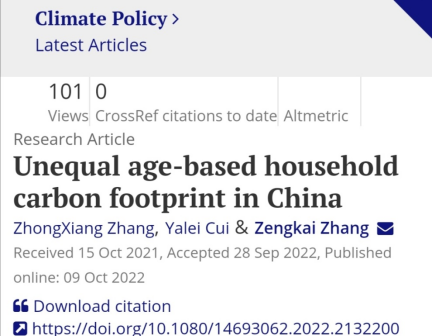时间:2022-10-26

天津大学马寅初经济学院创院院长、卓越教授张中祥和指导的博士研究生崔亚蕾与厦门大学张增凯教授合作的论文“Unequal age-based household carbon footprint in China”近期被SSCI公共管理类期刊Climate Policy接受,并在线发表。据该刊网站介绍,该刊接受率为20%;据2022年6月发布的Journal Citation Reports, 2021年该刊影响因子为6.056,位列SSCI公共管理学科49种期刊第4位。

(从左到右:张中祥、崔亚蕾、张增凯)
减缓全球碳排放量不断增加引导的持续加强的温室效应是本世纪全球面临的最主要挑战之一,了解碳排放的来源、构成和趋势对制定政策、应对挑战至关重要。研究发现,基于消费端碳排放核算,全球约三分之二的碳排放与家庭有关。
以往对家庭碳排放的研究主要集中在家庭收入、规模等方面,其中收入因素被认为是家庭碳足迹的主要驱动因素,但这不能解释低收入老年家庭的碳密集型消费行为。中国人口老龄化程度日益加深,据世界银行预测,2050年中国65岁以上人口预计将占到总人口的26%。人口老龄化改变了社会生产和消费的主体,导致了碳排放来源和数量的变化。现有少数关于老龄化和家庭碳排放的研究集中在发达国家,那么发展中国家老年人的消费态度和行为是否与发达国家有相同趋势?
针对上述问题,本文从反映不同年龄阶段家庭消费结构的微观数据入手,并与投入产出模型结合,探究了不同年龄组家庭消费驱动下的碳足迹演变,进而对未来家庭碳足迹进行模拟,以期为中国制定未来老龄化社会的气候减缓策略提供参考。
文章的边际贡献主要在以下两方面。首先,本文构建了基于年龄的环境扩展投入产出模型,拓展了消费端碳足迹核算方法;其次,本文通过将家庭微观数据和宏观经济数据相结合,发现家庭碳足迹随年龄演变趋势,丰富了家庭碳足迹异质性研究的视角。
文章研究发现,在中国,家庭碳足迹总量随着年龄的增长呈现倒U型变化,老年家庭(户主年龄在65岁及以上)碳足迹总量最低,中年家庭(户主年龄在45岁到54岁之间)碳足迹总量最高;家庭户均碳足迹随户主年龄增长而减少,老年家庭仍然最低,表明中国以老年人为经济支柱的家庭呈现出比其他家庭更低碳的消费模式;然而,老年家庭的内部直接碳足迹占比高于其他年龄段家庭。除此之外,本文还关注了城市化的影响,结果显示所有年龄段的城市家庭碳足迹都高于农村家庭,其中老年家庭的城乡差距最大;农村家庭的直接碳足迹占比高于城市家庭。预测结果显示,虽然中国老年家庭的平均家庭碳足迹较低,但随着老年家庭数量的增加,其碳足迹总量将持续攀升,因此需要在未来的气候政策中予以充分重视。

Unequal age-based household carbon footprint in China
ZhongXiang Zhang, Yalei Cui & Zengkai Zhang
Abstract
Controlling household consumption is an essential means to achieve carbon neutrality in China, and population ageing has an important impact on its structure. Since older people exhibit different consumption patterns than younger people, an increase in the proportion of aged people affects overall consumption patterns. This paper adopts an input–output model to reflect the heterogeneity in the consumption structure and household carbon footprint of different age groups, followed by a simulation of the future household carbon footprint. The results find that in China, the total household carbon footprint shows an inverted U-shape with age, with the lowest total carbon footprint coming from aged households (age of household head 65 and above) and the highest total carbon footprint from middle-aged households (age of household head 45–54). The average household carbon footprint decreases with age, with aged households remaining the lowest. Aged households, however, have the highest share of the direct carbon footprint. Interestingly, urban households of all ages have a higher carbon footprint than rural households, with the largest difference being among aged households. The projection results show that based on demographic changes, although the average household carbon footprint of elderly households in China is low, as the number of elderly households increases, the total carbon footprint of elderly households will be sizable and need to be taken seriously.
Key policy insights
· The total carbon footprint of elderly households will become more significant and sizable as the number of elderly households increases.
· Urban life is more carbon-intensive, and China’s urbanization is leading to an increase in the carbon footprint.
· Aged households require more attention in future climate policies.
· Targeted, consumption-based climate policies are necessary for carbon reduction in China and will have relevance in other countries with similar consumption structure and demographic trends, e.g. with ageing or rapidly urbanizing populations.
To cite this article: ZhongXiang Zhang, Yalei Cui & Zengkai Zhang (2022): Unequal age-based household carbon footprint in China, Climate Policy, DOI: 10.1080/14693062.2022.2132200.